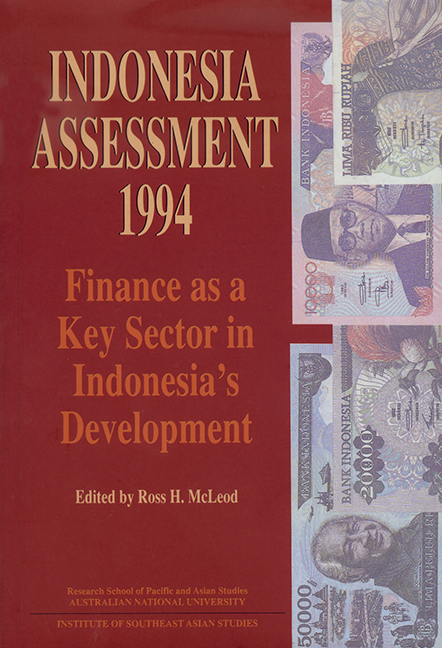Book contents
- Frontmatter
- Contents
- Tables, figures, appendices
- Foreword
- Glossary
- Contributors
- Acknowledgements
- 1 Introduction
- PART A ECONOMIC AND POLITICAL DEVELOPMENTS
- PART B FINANCE AS A KEY SECTOR IN INDONESIA'S DEVELOPMENT
- I The Reform Process
- II Monetary and Exchange Rate Policy
- III Banking Sector Reforms
- 8 Banking sector reforms in Indonesia, 1983-93
- 9 Bank soundness requirements: a central bank perspective
- 10 Bank soundness requirements: a commercial bank perspective
- 11 The case against deposit insurance in Indonesia
- IV Domestic and International Capital Markets
- V Small-scale Finance
- References
- Index
8 - Banking sector reforms in Indonesia, 1983-93
from III - Banking Sector Reforms
Published online by Cambridge University Press: 21 October 2015
- Frontmatter
- Contents
- Tables, figures, appendices
- Foreword
- Glossary
- Contributors
- Acknowledgements
- 1 Introduction
- PART A ECONOMIC AND POLITICAL DEVELOPMENTS
- PART B FINANCE AS A KEY SECTOR IN INDONESIA'S DEVELOPMENT
- I The Reform Process
- II Monetary and Exchange Rate Policy
- III Banking Sector Reforms
- 8 Banking sector reforms in Indonesia, 1983-93
- 9 Bank soundness requirements: a central bank perspective
- 10 Bank soundness requirements: a commercial bank perspective
- 11 The case against deposit insurance in Indonesia
- IV Domestic and International Capital Markets
- V Small-scale Finance
- References
- Index
Summary
Introduction
External shocks, coupled with stagnant investment and economic growth in the early 1980s, forced Indonesia to pursue drastic adjustment policies. Between 1983 and 1985, the focus was on short-run stabilisation—in particular, on restoring external creditworthiness by cutting domestic absorption. But soon it became apparent that short-term stabilisation measures alone would be insufficient to restore long-term growth. The stabilisation policy was thus complemented by broad-based policy reforms aimed at increasing domestic savings mobilisation and the efficiency of resource use. These reforms changed the emphasis of Indonesia's development strategy from heavy reliance on the public sector, import-substitution industrial policy, and financial repression, to export-oriented industrial policies and market-based financial policies, combined with far greater emphasis on the private sector.
This paper focuses on policy reforms in the banking industry since 1983. It begins by reviewing the macroeconomic background, the financial sector, and aspects of competition in the economy. It then provides an overview of policy reforms over the last decade in the banking industry before looking at the more important reforms in detail, giving particular attention to difficulties in implementing the new prudential regulations. The impacts of the reforms are then analysed and, finally, a summary of what has been done and what remains to be achieved is presented.
Macroeconomic background
During the period since 1966, economic development in Indonesia has been hailed for its three success stories: first, the rapid suppression of hyperinflation and transition from a controlled to a market-based economic system during the second half of the 1960s; second, successful exchange rate management to avoid the ‘Dutch disease’ problem during the 1973 to 1982 oil-boom period; and third, the rapid transition from heavy dependence on oil in the late 1980s.
Over the past twenty years Indonesia, together with its ASEAN partners and the Asian newly industrialising economies, has been regarded as one of the most dynamic countries in the international economy (World Bank 1993a:!).
- Type
- Chapter
- Information
- Indonesia Assessment 1994Finance as a Key Sector in Indonesia's Development, pp. 130 - 157Publisher: ISEAS–Yusof Ishak InstitutePrint publication year: 1994

